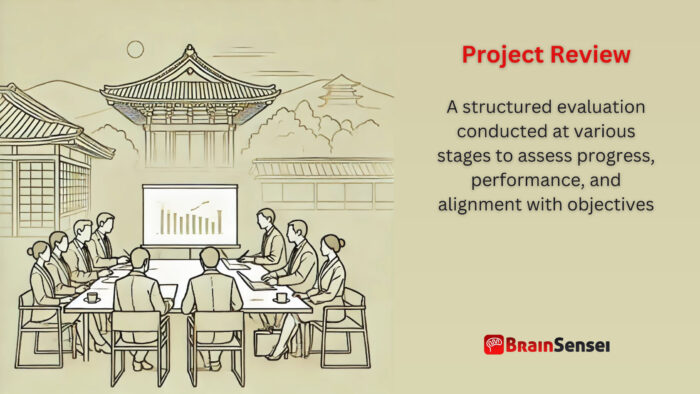
Project Review
What is a Project Review?
A project review is a structured evaluation conducted at various stages to assess progress, performance, and alignment with objectives. These reviews help identify risks, inefficiencies, and areas for improvement, ensuring successful project completion. Reviews can occur at the initiation, mid-project, and post-completion phases, depending on the project’s needs.
Key Takeaways
- A review formally assesses a project’s status, performance, and outcomes.
- It helps identify risks, inefficiencies, and improvement areas.
- Reviews occur at different project phases: initiation, progress, and post-completion.
- They provide valuable insights for stakeholders and future projects.
- Effective reviews enhance accountability, efficiency, and overall success.
Understanding Project Review
How It Works
A review follows a structured data collection, analysis, and reporting process. It includes input from stakeholders, team members, and project documentation. Depending on the review type, it may focus on budget compliance, timeline adherence, risk management, stakeholder satisfaction, or deliverable quality.
Notes
- Initiation reviews ensure the project scope and goals are well-defined.
- Mid-project reviews help monitor progress and resolve issues early.
- Post-project reviews evaluate overall success and lessons learned.
- External reviews involve third-party auditors for an unbiased assessment.
- Agile projects use frequent sprint reviews to maintain alignment and adaptability.
Related Terms
- Project Audit: A formal, independent review focusing on compliance and adherence to standards.
- Project Retrospective: A reflection session after project completion, commonly used in Agile methodologies.
- Lessons Learned: Document key insights gained during the project lifecycle.
- Risk Assessment: Evaluation of potential risks and mitigation strategies during a review.
- Performance Evaluation: Measurement of team and individual contributions to project success.
- Stakeholder Feedback: A collection of input from project sponsors, clients, and team members.
Examples of Project Review in Different Industries
Construction Industry – Mid-Project Review
A construction company managing a large infrastructure project conducts a review halfway through the project to evaluate budget usage, safety compliance, and timeline adherence. The review identifies supply chain delays and recommends alternative suppliers, preventing significant cost overruns. By adjusting procurement strategies and renegotiating contracts, the company ensures smoother operations and better contingency planning. Additionally, worker safety incidents are analyzed, leading to enhanced training programs that reduce future risks.
IT & Software Industry – Agile Sprint Review
A software development firm holds a sprint review at the end of each two-week cycle. The review helps assess completed features, gather client feedback, and adjust development priorities, ensuring the final product meets evolving user needs. The team reviewed an e-commerce platform upgrade in one project and revealed performance issues under heavy traffic loads. Developers used this feedback to optimize code and improve the platform’s scalability. The review process also uncovered gaps in UI design, prompting enhancements that increased user engagement and satisfaction.
Healthcare Industry – Post-Project Evaluation
A hospital implements a new patient management system. After implementation, the hospital evaluates the system’s effectiveness, staff adoption rates, and patient satisfaction. Findings highlight training gaps, leading to additional user support initiatives. The review also identifies data integration challenges, prompting collaboration with IT teams to refine system functionality. Patient feedback plays a crucial role, revealing usability issues that, once addressed, streamline workflows and reduce administrative burdens on medical staff. Future implementation strategies benefit from these insights, improving hospital-wide technology adoption.
Use Cases of Project Review Application
United States (Financial Services)
A financial institution in New York conducts a review after launching a new digital banking platform. The review identifies customer service bottlenecks and recommends AI-driven chat support, improving user experience. Additionally, the IT team assesses cybersecurity vulnerabilities, which leads to enhanced data protection measures. As a result of these findings, the company revises its customer onboarding process, reducing account activation time by 30% and boosting user retention rates. The lessons learned from this review inform future fintech product rollouts, improving service efficiency and security compliance. Further analysis highlights inefficiencies in cross-border payment transactions, leading to the adoption of blockchain technology to streamline operations and reduce transaction costs.
Germany (Manufacturing)
A German automobile manufacturer reviews a factory automation project to assess efficiency gains. The review results in process optimization strategies, reducing production costs by 15%. Engineers identify machinery bottlenecks and introduce predictive maintenance, minimizing downtime. Employee feedback highlights workflow inefficiencies, leading to redesigned workstation layouts that improve productivity. Environmental sustainability goals are also addressed, with the review prompting the adoption of energy-efficient equipment, cutting carbon emissions significantly. The comprehensive evaluation strengthens future automation initiatives and enhances overall factory performance. A subsequent follow-up identifies opportunities for integrating AI-driven quality control, improving defect detection rates and reducing waste in the production process.
India (Telecommunications Industry)
A telecommunications provider in India assesses a nationwide 5G rollout. The review reveals network coverage gaps, prompting adjustments in infrastructure deployment plans. Customer feedback highlights connectivity issues in rural areas, leading to targeted expansion strategies. Financial analysis identifies budget overruns, prompting negotiations with suppliers to optimize resource allocation. The review also uncovers technical challenges related to signal interference, leading to advanced engineering solutions that enhance service reliability. By incorporating these insights, the company ensures a more seamless and scalable 5G network deployment. Additionally, the review highlights a need for enhanced cybersecurity protocols to prevent data breaches in the high-speed network infrastructure.
Best Practices for an Effective Project Review
To conduct an effective review of a project, follow these best practices:
Establish clear objectives
Define the review’s goals, such as assessing performance, identifying risks, or documenting lessons learned.
Involve all key stakeholders.
Engage project managers, team members, sponsors, and clients for a comprehensive perspective.
Use data-driven analysis
Base findings on measurable data, such as budget usage, timeline adherence, and performance metrics.
Document insights and action items
Keep records of findings and ensure corrective actions are assigned and followed up.
Schedule reviews at key milestones
Conduct reviews at project initiation, mid-project, and post-completion stages for timely adjustments.
Encourage open and honest feedback
Foster a culture where stakeholders feel comfortable sharing challenges and concerns.
Leverage project management tools
Utilize software like Jira, Trello, or Microsoft Project to track and analyze project data effectively.
Follow up with implementation plans
Ensure that issues identified in reviews lead to tangible improvements in future projects.
Customize review formats
Tailor the review process to fit project size, complexity, and industry-specific requirements.
Conduct external reviews when necessary
Engage third-party auditors for an unbiased perspective, especially in compliance-heavy industries.
Implementing these best practices can enhance project performance, improve stakeholder satisfaction, and increase overall efficiency. Practical reviews foster continuous learning and adaptation, contributing to long-term success.
Common Mistakes and Issues
One of the most common mistakes in project reviews is failing to conduct them at regular intervals. Projects that skip reviews midway through often encounter unexpected issues late in the cycle, leading to budget overruns and delays. Another common issue is a lack of stakeholder involvement. Teams that do not include key stakeholders in the review process may miss critical insights, and the outcome may not meet stakeholder expectations.
Additionally, some organizations focus only on negative findings in a review, creating a culture of blame rather than constructive learning. This approach discourages transparency and makes team members hesitant to report issues early. Instead, a balanced approach highlighting successes and areas for improvement fosters a positive learning environment.
Poor documentation creates another critical issue. Without well-documented findings and action items, teams lose valuable lessons and may repeat mistakes in future projects. Teams can mitigate this issue by implementing a structured review template and following up appropriately.
Finally, ignoring review recommendations can render the entire process ineffective. Project managers should ensure that insights gained from reviews lead to actionable changes in project planning and execution. A well-executed review provides a roadmap for continuous improvement and enhances organizational efficiency.
Frequently Asked Questions (FAQs)
What is the purpose of a project review?
A review assesses performance, identifies risks, and ensures alignment with objectives to improve outcomes.
How often should project reviews be conducted?
Reviews should occur at significant project milestones: initiation, mid-project, and post-completion. Agile projects may conduct sprint reviews more frequently.
Who should be involved in a project review?
A well-rounded evaluation should involve project managers, stakeholders, team members, and external auditors (if necessary).
How does a project review differ from an audit?
A review is an internal evaluation focusing on performance and improvement, whereas an audit is a formal, often external, assessment of compliance and standards.
What tools can help with project reviews?
Project management software, such as Jira, Trello, and Microsoft Project, can facilitate data collection and reporting for effective reviews.
Additional Resources
Preparing for a PMI certification?
- Exam Prep Courses: PMP®, CAPM®, and PMI-ACP®
- Exam Simulators: PMP®, CAPM®, PMI-ACP®, PMI-PBA®, PMI-RMP®, PMI-SP®, PgMP®, and PfMP®
- Professional Development Units (PDUs): 15, 30, and 60 PDU Bundles



